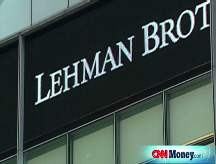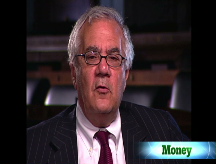Fed's next move could be to lower rates
The central bank is likely to keep its key interest rate at 2% at its September 16 meeting but expectations are growing for a rate cut before year's end.

NEW YORK (CNNMoney.com) -- While the Federal Reserve is widely expected to once again hold a key interest rate at 2% when it meets on Tuesday, there is a growing sense that the Fed may have to cut rates by the end of the year.
If the Fed does so, it would mark a dramatic change in the central bank's assessment of the economy. As recently as the Fed's last meeting in August, Fed members indicated that their next move would be to hike rates at some undetermined point in the future in order to fight inflation.
The Fed typically lowers interest rates during an economic slowdown in order to stimulate more borrowing and looks to raise them when it is more concerned about inflation.
The Fed slashed its federal funds rate, an overnight bank lending rate that helps determine how much interest consumers and businesses pay on various types of loans, seven times from September of last year through April in an attempt to minimize the damage from the mortgage crisis and credit crunch.
But the Fed has left rates unchanged at its past two meetings and started to indicate that it was growing more worried about rising commodity prices, particularly oil.
However, the U.S. economy, which once seemed on the verge of a recovery in the second-half of the year, has recently shown signs of weakening further.
The unemployment rate jumped to 6.1% in August, the highest level in nearly 5 years. Economic growth is also slowing overseas. That could cut demand for U.S. exports, which was a main driver of the economic growth in the second quarter.
Thomson Reuters forecasts that third quarter corporate earnings will be flat, as losses continue to mount in the financial sector. And troubled mortgage giants Fannie Mae (FNM, Fortune 500) and Freddie Mac (FRE, Fortune 500), which own or back more than $5 trillion in home loans, were seized by the Treasury Department this week.
At the same time, oil prices have fallen sharply from their record highs and the dollar has rebounded against the euro. Thus, some think the threat of inflation is receding.
With this in mind, one economist said that so-called inflation doves, those who argue economic weakness is a greater threat than inflation, have ample reason to call for a rate cut.
"Like Prince said, 'This is what it sounds like when doves cry,'" said Bob Brusca of FAO Economics, who is predicting that the Fed will lower rates before the end of the year.
"Up to this point, the job losses haven't been that bad. But the measures that the Fed looks at below the surface have got to make them worried," said Brusca. "When the economy is moving sideways, it's one thing to leave rates unchanged. When it's moving lower, it's another."
To be sure, there are still inflation hawks on the Fed, those who believe the central bank should be raising rates to keep prices in check.
Dallas Fed President Richard Fisher voted for rate hikes at the Fed's last two meetings. And in April, he and Philadelphia Fed President Charles Plosser voted against a rate cut.
But Brusca pointed to a recent speech by San Francisco Fed President Janet Yellen as a sign that the Fed may no longer consider rising prices a serious threat.
Earlier this month, Yellen said there has been "a shift in the inflation picture" and that she is now "very hopeful that inflation will come down quite substantially."
While Yellen is not currently a member of the central bank's rate-setting Fed Open Market Committee, she attends the meetings and is seen as an influential voice.
"Yes, she's a dove, but it's clear the doves are coming out of their shells," said Brusca.
Investors have noticed. According to interest rate futures on the Chicago Board of Trade, investors are even pricing in a 9% chance of a rate cut on the September 16 meeting.
By way of comparison, on September 9, the futures pointed to a 3% chance of a rate hike at the September meeting. And as recently as last month, the futures priced in a 54% chance of a rate increase at the Fed's next meeting, a two-day session that concludes on October 29.
Of course, the likelihood of a cut is still small. And one economist said that rate cuts could do more harm than good since it might spook investors and businesses already worried about the fragile state of the economy more than it would help lift spending or borrowing.
"It would send a clear signal that [the Fed] felt there were still more shoes to drop, more trouble ahead," said David Kelly, chief market strategist for JPMorgan Funds.
He added that the Fed wouldn't want to lower rates much further just yet because it would limit its ability to respond to some future shock to the financial system with more rate cuts.
But another economist suggested that another cut later this year or early next year is justified because of expectations that the economy will continue to get worse.
"If you need it now, you should use it," said Keith Hembre, chief economist with First American Funds, about the option of a rate cut sooner rather than later. "I don't know what you'd want to save it for." ![]()




